Vereenvoudigde SMB-clusternetwerken met meerdere kanalen en meerdere NIC-clusters
De vereenvoudigde SMB Multichannel- en Multi-Network Interface Card (NIC) clusternetwerken zijn een functie die het gebruik van meerdere NIC's binnen hetzelfde clusternetwerksubnet mogelijk maakt en automatisch SMB Multichannel inschakelt.
Vereenvoudigde SMB-clusternetwerken met meerdere kanalen en meerdere NIC-clusters bieden de volgende voordelen:
- Failoverclustering herkent automatisch alle NIC's op knooppunten die dezelfde switch/hetzelfde subnet gebruiken. Er is geen extra configuratie nodig.
- SMB Multichannel wordt automatisch ingeschakeld.
- Netwerken die alleen IPv6 Link Local (fe80) IP-adressen hebben, worden herkend op netwerken die alleen voor clusters (privé) zijn bestemd.
- Standaard wordt er op iedere Cluster Access Point (CAP) Network Name (NN) één IP-adresresource geconfigureerd.
- Bij clustervalidatie worden geen waarschuwingsberichten meer weergegeven wanneer er meerdere NIC's in hetzelfde subnet worden gevonden.
Voorwaarden
- Meerdere NIC's per server met dezelfde switch/subnet.
Hoe te profiteren van multi-NIC-clusternetwerken en vereenvoudigde SMB multichannel
In deze sectie wordt beschreven hoe u kunt profiteren van de nieuwe netwerken met meerdere NIC-clusters en vereenvoudigde SMB-functies voor meerdere kanalen.
Ten minste twee netwerken gebruiken voor failoverclustering
Hoewel het zeldzaam is, kunnen netwerkswitches mislukken. Het is nog steeds raadzaam om ten minste twee netwerken te gebruiken voor failoverclustering. Alle gevonden netwerken worden gebruikt voor clusterheartbeats. Vermijd het gebruik van één netwerk voor uw failovercluster om een single point of failure te voorkomen. Idealiter zijn er meerdere fysieke communicatiepaden tussen de knooppunten in het cluster en geen single point of failure.
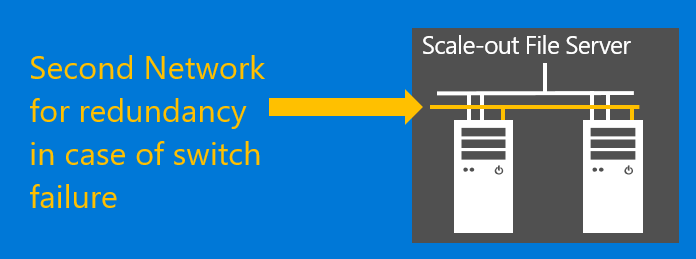
afbeelding 1: Gebruik ten minste twee netwerken voor failoverclustering
Meerdere NIC's in clusters gebruiken
Het maximale voordeel van het vereenvoudigde SMB-multikanaal wordt bereikt wanneer meerdere NIC's worden gebruikt in clusters, zowel in opslag- als opslagworkloadclusters. Hierdoor kunnen de workloadclusters (Hyper-V, SQL Server Failover Cluster Instance, Storage Replica, enzovoort) gebruikmaken van SMB Multichannel, wat resulteert in efficiënter netwerkgebruik. In een geconvergeerde (ook wel bekend als niet-geaggregeerde) clusterconfiguratie waarbij een scale-out bestandsservercluster wordt gebruikt voor het opslaan van workloadgegevens voor een cluster met Hyper-V- of SQL Server-failoverclusterexemplaren, wordt dit netwerk vaak 'het North-South subnet' of het netwerk genoemd. Veel klanten maximaliseren de doorvoer van dit netwerk door te investeren in RDMA-compatibele NIC-kaarten en switches.
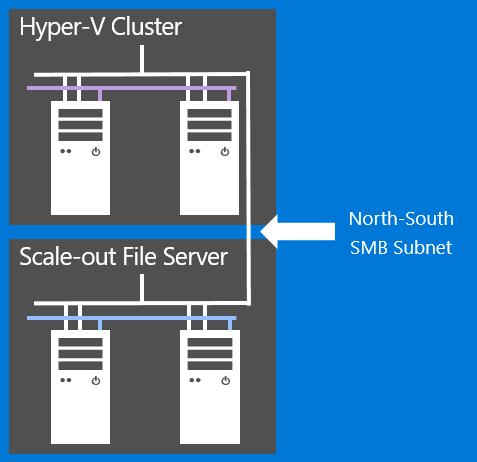
Afbeelding 2: Om maximale netwerkdoorvoer te bereiken, gebruikt u meerdere NIC's op zowel het Scale-out Bestandsservercluster als het cluster Hyper-V of SQL Server Failoverclusterinstantie, die samen het North-South subnet delen.
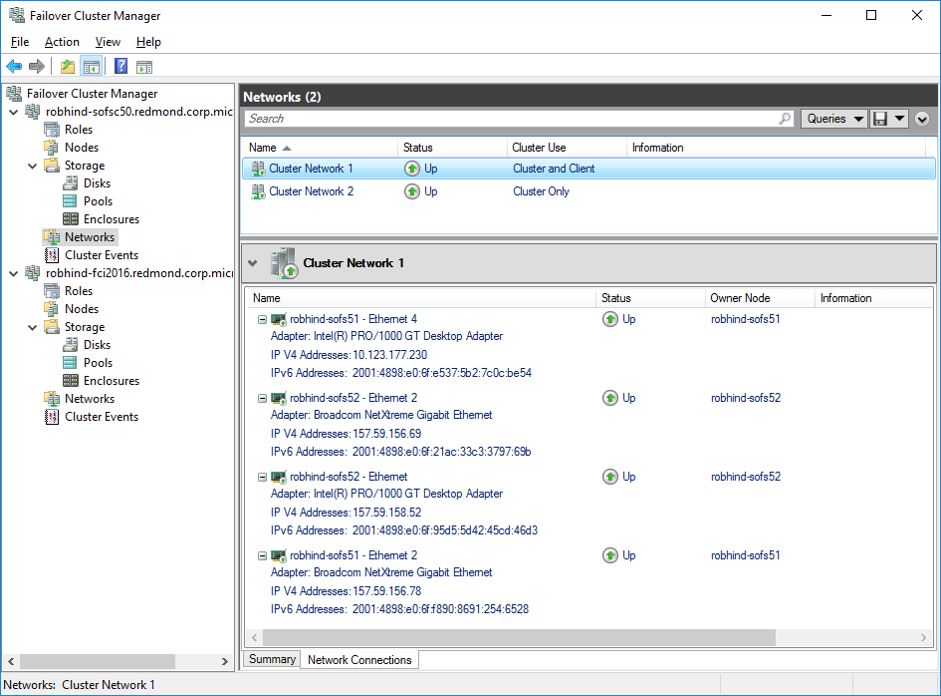
nl-NL: Afbeelding 3: Twee clusters (Scale-out Bestandsserver voor opslag, SQL Server Failover Clustering Instance (FCI) voor workload) gebruiken beide meerdere NICs in hetzelfde subnet om gebruik te maken van SMB Multichannel en om betere netwerkdoorvoer te bereiken.
Automatische herkenning van lokale particuliere IPv6 Link-netwerken
Wanneer u meer dan één privénetwerk (alleen clusternetwerk) gebruikt, controleert u de configuratie van de IPv6-routering om ervoor te zorgen dat routering niet is geconfigureerd voor subnetten, omdat dit de netwerkprestaties vermindert.
Wanneer u meer dan één privénetwerk (alleen clusternetwerk) gebruikt, controleert u de configuratie van de IPv6-routering om ervoor te zorgen dat routering niet is geconfigureerd voor subnetten, omdat dit de netwerkprestaties vermindert.
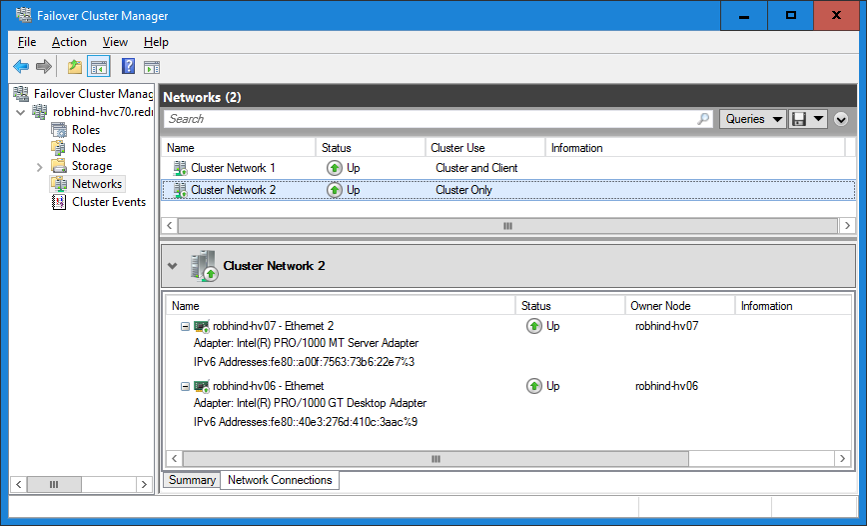
afbeelding 4: Configuratie van adresresources voor automatische IPv6-koppeling (fe80)
Doorvoer en fouttolerantie
Windows Server 2016 en hoger detecteert automatisch NIC-mogelijkheden en probeert elke NIC in de snelst mogelijke configuratie te gebruiken. NIC's die zijn gekoppeld, NIC's die gebruikmaken van RSS en NIC's met RDMA-functionaliteit, kunnen allemaal worden gebruikt. De onderstaande tabel bevat een overzicht van de afwegingen bij het gebruik van deze technologieën. Maximale doorvoer wordt bereikt wanneer u meerdere NIC's met RDMA-functionaliteit gebruikt. Voor meer informatie, zie De basisprincipes van SMB-multichannel.
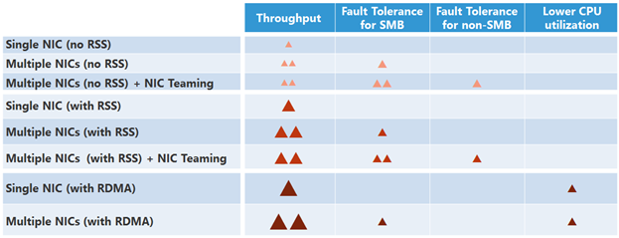
afbeelding 5: Doorvoer en fouttolerantie voor verschillende NIC-configuraties
Veelgestelde vragen
Worden alle NIC's in een multi-NIC-netwerk gebruikt voor het kloppen van clusterharten? Beide configuraties werken: alle clusternetwerkrollen werken in een multi-NIC-netwerk.
Kan een multi-NIC-netwerk alleen worden gebruikt voor clustercommunicatie? Of kan deze alleen worden gebruikt voor client- en clustercommunicatie? Ja, standaard gebruiken alle cluster- en CSV-verkeer beschikbare multi-NIC-netwerken. Beheerders kunnen de PowerShell-cmdlets voor failoverclustering of de gebruikersinterface van Failoverclusterbeheer gebruiken om de netwerkrol te wijzigen.
Wordt SMB meerdere kanalen ook gebruikt voor CSV- en clusterverkeer? Ja, standaard gebruiken alle cluster- en CSV-verkeer beschikbare multi-NIC-netwerken. Beheerders kunnen de PowerShell-cmdlets voor failoverclustering of de gebruikersinterface van Failoverclusterbeheer gebruiken om de netwerkrol te wijzigen.
Hoe zie ik de SMB-instellingen voor meerdere kanalen? Gebruik de cmdlet Get-SMBServerConfiguration en zoek naar de waarde van de eigenschap EnableMultiChannel.
Wordt de algemene clustereigenschap PlumbAllCrossSubnetRoutes gerespecteerd op een multi-NIC-netwerk? Ja.